McDonnell Douglas - Picture
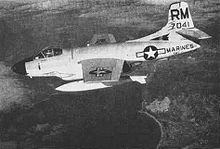
|
|
McDonnell Douglas
Predecessor: McDonnell Aircraft
Douglas Aircraft
Successor: The Boeing Company
Founded: April 28, 1967
Defunct: August 1, 1997
Headquarters: Berkeley, Missouri, United States
Website: MDC.com (archived copy)
McDonnell Douglas was a major American aerospace manufacturer and defense contractor, producing a number of famous commercial and military aircraft. It formed from a merger of McDonnell Aircraft and Douglas Aircraft in 1967. McDonnell Douglas was based at St. Louis's Lambert International Airport, in Berkeley, Missouri, near the city of St. Louis. The McDonnell Douglas Technical Services Company (MDTSC), a subsidiary of McDonnell Douglas, was headquartered in unincorporated St. Louis County, Missouri, United States. McDonnell Douglas later merged with its rival, Boeing, in 1997.
Background

Picture - Douglas F3D Skyknight
The company was formed from the firms of James Smith McDonnell and Donald Wills Douglas in 1967. Both men were of Scottish ancestry, graduates of MIT and had worked for the aircraft manufacturer Glenn L. Martin Company. Douglas had been chief engineer at Martin before leaving to establish Davis-Douglas Company in early 1920 in Los Angeles. He bought out his backer and renamed the firm the Douglas Aircraft Company in 1921.
McDonnell founded J.S. McDonnell & Associates in Milwaukee, Wisconsin in 1926. His idea was to produce a personal aircraft for family use. The economic depression from 1929 ruined his ideas and the company collapsed. He worked at three companies with the final being Glenn Martin Company in 1933. He left Martin in 1938 to try again with his own firm, McDonnell Aircraft Corporation, this time based at Lambert Field, outside St. Louis, Missouri. World War II was a major earner for Douglas. The company produced almost 30,000 aircraft from 1942 to 1945 and the workforce swelled to 160,000. Both companies suffered at the end of hostilities, facing an end of government orders and a surplus of aircraft.
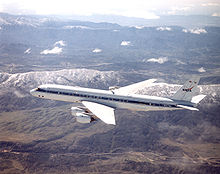
Picture - Douglas DC-8
After the war Douglas continued to develop new aircraft, including the DC-6 in 1946 and the DC-7 in 1953. The company moved into jet propulsion, producing their first for the military - the conventional F3D Skyknight in 1948 and then the more 'jet age' F4D Skyray in 1951. In 1955, Douglas introduced the first attack jet of the United States Navy with the A4D Skyhawk. Designed to operate from the decks of the World War II Essex class aircraft carriers, the Skyhawk was small, reliable, and tough. Variants of it continued in use in the Navy for almost 50 years, finally serving in large numbers in a two-seat version as a jet trainer.
Douglas also made commercial jets, producing the DC-8 in 1958 to compete with the Boeing 707. McDonnell was also developing jets, but being smaller they were prepared to be more radical, building on their successful FH-1 Phantom to become a major supplier to the Navy with the F2H Banshee, F3H Demon, and the F-101 Voodoo. The advent of the Korean War Banshee and later Vietnam War F-4 Phantom II helped push McDonnell into a major military fighter supply role.
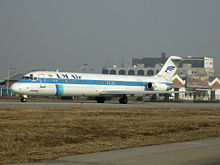
Picture - McDonnell Douglas DC-9
Both companies were eager to enter the new missile business, Douglas moving from producing air-to-air rockets and missiles to entire missile systems under the 1956 Nike program and becoming the main contractor of the Skybolt ALBM program and the Thor ballistic missile program. McDonnell made a number of missiles, including the unusual ADM-20 Quail, as well as experimenting with hypersonic flight, research that enabled them to gain a substantial share of the NASA projects Mercury and Gemini. Douglas also gained contracts from NASA, notably for part of the enormous Saturn V rocket. Both companies were now major employers, but both were having problems.
Douglas was strained by the cost of the DC-8 and DC-9, and the companies began to sound each other out about a merger. Inquiries began in 1963; Douglas offered bid invitations from December 1966 and accepted that of McDonnell. The two firms were officially merged on April 28, 1967 as the McDonnell Douglas Corporation (MDC).
History
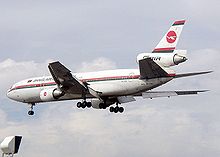
Picture - McDonnell Douglas DC-10
In 1967, with the merger of McDonnell and Douglas Aircraft, Dave Lewis, then president of McDonnell, was named chairman of what was called the Long Beach, Douglas Aircraft Division. At the time of the merger, Douglas Aircraft was estimated to be less than a year from bankruptcy. Flush with orders, the DC-8 and DC-9 aircraft were 9 to 18 months behind schedule, incurring stiff penalties from the airlines. Lewis was active in DC-10 sales in an intense competition with Lockheed's L-1011, a rival tri-jet aircraft. In two years, Mr. Lewis had the operation back on track and in positive cash flow. He returned to the company's St. Louis headquarters where he continued sales efforts on the DC-10 and managed the company as a whole as President and Chief Operating Officer through 1971.
The DC-10 began production in 1968 with the first deliveries in 1971. Several artists impressions exist of an aircraft named the "DC-10 Twin" or DC-X which McDonnell Douglas considered in the early 1970s but never built. This would have been an early twinjet with a striking likeness to the Airbus A300 and similar performance characteristics, which was never progressed to a prototype. It could be argued that this was a major mistake on the part of McDonnell Douglas as it would have given them an early lead in the huge twinjet market that subsequently developed, as well as commonality with much of the DC-10's systems and engineering.
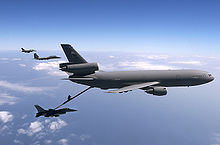
Picture - KC-10 Extender during refueling
In 1977, the next generation of DC-9 variants, dubbed the "Super 80" (later renamed the MD-80) series, was launched. The following aircraft to be launched was the MD-11 in 1986, an improved and upgraded version of DC-10. To date the MD-11 remains the most advanced trijet aircraft to be developed. After its launch in 1986, the MD-11 sold 200 units, but was discontinued in 2001 after the merger with Boeing as it competed with the Boeing 777, and was relatively accident-prone. The final commercial aircraft design to be made by McDonnell Douglas came in 1988. The MD-90 was a stretched version of the earlier MD-80, equipped with International Aero Engines V2500 turbofans, the largest rear-mounted engines ever on a commercial jet. The MD-95, a modern regional airliner closely resembling the DC-9-30, was the last McDonnell Douglas designed commercial jet produced.
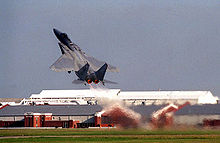
Picture - F-15C on takeoff
In 1977 the KC-10 Extender was the second McDonnell Douglas transport aircraft to be selected for use by the US Air Force; the first being the C-9 Nightingale/Skytrain II. However the purchasing of both aircraft was curtailed as the Cold War came to an abrupt end in the 1990s. This curtailment in military procurements combined with the loss of the contracts for two major projects, the Advanced Tactical Fighter and Joint Strike Fighter, severely hurt McDonnell Douglas. Through the years of the Cold War McDonnell Douglas had introduced and manufactured dozens of successful military aircraft, including the F-15 Eagle in 1974, the F/A-18 Hornet in 1978, and other products such as the Harpoon and Tomahawk missiles. The oil crisis of the 1970s was a serious shock to the commercial aviation industry, as a major manufacturer of commercial aircraft at the time, McDonnell Douglas was hit by the economic shift and forced to contract heavily while diversifying into new areas to reduce the impact of potential future downturns.
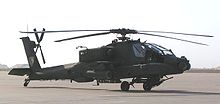
Picture - AH-64 Apache attack helicopter
In 1984, McDonnell Douglas expanded into helicopters by purchasing Hughes Helicopters from the Summa Corporation for $470 million. Hughes Helicopters was made a subsidiary initially and renamed McDonnell Douglas Helicopter Systems in August 1984. McDonnell Douglas Helicopters's most successful product was the Hughes-designed AH-64 Apache attack helicopter.
On January 13, 1988, McDonnell Douglas and General Dynamics won the US Navy Advanced Tactical Aircraft (ATA) contract. The $US4.83 billion contract was to develop the A-12 Avenger II, a stealthy, carrier-based, long range flying wing attack aircraft that would replace the A-6 Intruder. Technical issues, over 2 billion dollars in development cost overruns, growing unit costs, and continuous delays led to the termination of the program on January 13, 1991 by then Defense Secretary Dick Cheney. A decade of litigation would proceed over the contract termination: the government claimed that the contractors had defaulted on the contract and were not entitled to a final 1.3 billion dollars in progress payments while McDonnell Douglas and General Dynamics believed that the contract was terminated out of convenience and thus the money was owed. As of 2007, the case continues to sit in litigation. The chaos and financial stress created by the collapse of the A-12 program led to the layoff of 5,600 employees. The advanced tactical aircraft role vacated by the A-12 debacle would be filled by another McDonnell Douglas program, the F/A-18E/F Super Hornet.
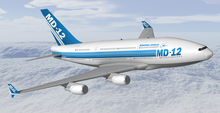
Picture - McDonnell Douglas MD-12 aircraft concept
In 1992, McDonnell Douglas unveiled a study of a double deck jumbo-sized aircraft designated MD-12. Despite briefly exciting the market, the study was perceived as merely a public relations exercise to disguise the fact that MDC was struggling under intense pressure from Boeing and Airbus. It was clear to most in the industry that MDC had neither the resources nor the money to develop such a large aircraft, and the study quickly sank without trace. A similar double deck concept was used in Boeing's later Ultra-Large Aircraft study intended to replace the 747, but ultimately the double deck concept would not see the light of day until the Airbus A380 in the 2000s.
Following Boeing's 1996 acquisition of Rockwell's North American division, McDonnell Douglas merged with Boeing in 1997 in a US$13 billion stock-swap to create The Boeing Company.
Products
Military airplanes
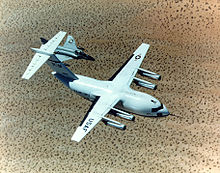
Picture - The McDonnell Douglas YC-15 was used as the base for the C-17.
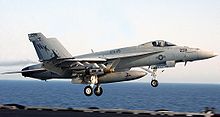
Picture - F/A-18E Super Hornet
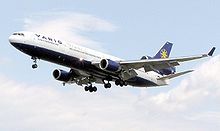
Picture - Built from 1988-2000, the MD-11 was the last McDonnell Douglas widebody aircraft.
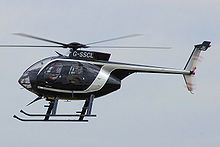
Picture - MD 500 Helicopter.
A-4 Skyhawk (started under Douglas Aircraft)
F-4 Phantom II (started under McDonnell Aircraft)
F-15 Eagle
AV-8B Harrier II (in partnership with British Aerospace)
F/A-18 Hornet
T-45 Goshawk jet trainer (in partnership with British Aerospace)
KC-10 Extender
C-17 Globemaster III (Design and early production)
F/A-18E/F Super Hornet (Design and early production)
Commercial airplanes
DC-9 (started under Douglas Aircraft)
DC-10 (with cockpit upgrade designated MD-10)
MD-11 (stretched and modernized version of the DC-10)
MD-80 Series (stretched and modernized version of the DC-9)
MD-90 (stretched and modernized version of the MD-80)
MD-95 (latest evolution of the DC-9, sold as Boeing 717)
Proposed models
McDonnell Douglas MD-12 (a double-decker plane similar to Airbus A380 and Boeing NLA)
Helicopters
AH-64 Apache (started under Hughes Helicopters)
MD 500 series (started under Hughes Helicopters)
MD 600
MD 901/902/902 Explorer
Computer systems
Sequel
Spirit
Reality OS
Series 18 Model 6
Series 18 Model 9
6200
6400
9000
9200
9400
The corporation also produced the Sovereign (later M8000) series of systems in the UK, which used the Soveriegn operating system developed in the UK and which was not based on Pick, unlike the "Reality" family of systems listed above.
Other
Tomahawk missile
Harpoon missile
Skylab space station
Delta II space launch vehicle
Greider, William. One World, Ready or Not. Penguin Press, 1997. ISBN 0-7139-9211-5.
Yenne, Bill. McDonnell Douglas. Crescent Books, 1985. ISBN 0-517-44287-6.
McDonnell Douglas Pictures and McDonnell Douglas for Sale.
Living Warbirds: The best warbirds DVD series.
Source: WikiPedia